Double-stops are a quick way to make your guitar sound fuller and more colorful without heavy chords. By playing two notes simultaneously on adjacent strings, you can create harmony, add depth to solos, and bring richness to progressions. Using common shapes like thirds, sixths, and power intervals helps you uncover bigger sounds easily. Keep exploring, and you’ll discover simple techniques to incorporate double-stops seamlessly into your playing to craft a more expressive tone.
Key Takeaways
- Double-stops allow guitarists to create richer, fuller chords by playing two notes simultaneously, mimicking larger chords.
- They enhance musical expression by adding harmony, depth, and colorful embellishments to melodies and progressions.
- Recognizing common shapes and intervals helps quickly incorporate double-stops into solos and chord voicings.
- Using double-stops strategically can replace full chords or add harmonic movement with fewer notes.
- Mastering double-stops develops finger independence and fretboard awareness, making chords sound bigger and more dynamic.
Understanding Double‑Stops and Their Role in Guitar Playing
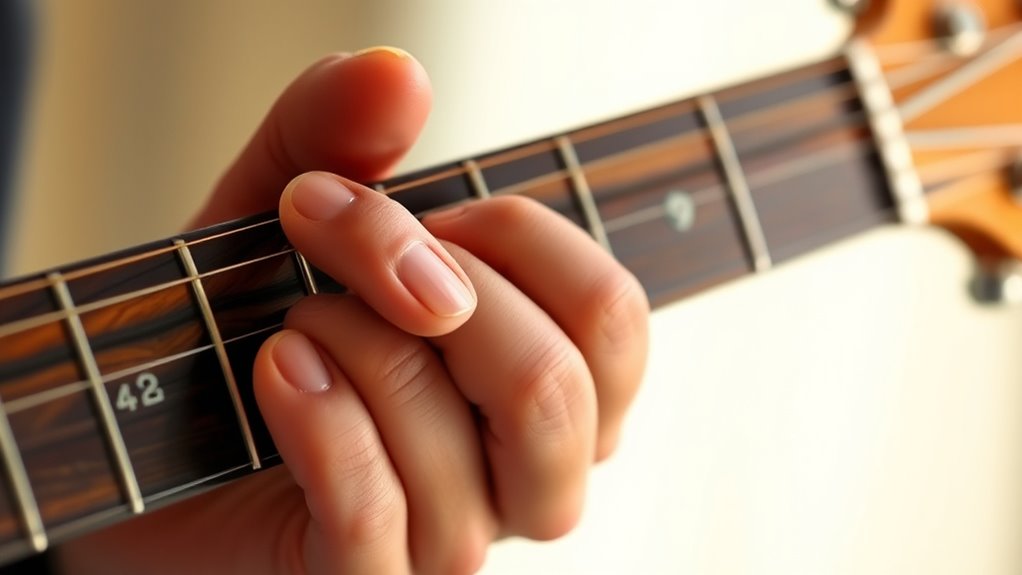
Double-stops are a fundamental technique that can add richness and complexity to your guitar playing. They involve playing two notes simultaneously, often on adjacent or nearby strings, to create harmony and depth. By incorporating double-stops, you can mimic the sound of full chords or add colorful embellishments to melodies. This technique is versatile, fitting into various styles like blues, jazz, and rock, giving you more expressive options. When you master double-stops, you reveal a way to make your solos sound fuller without switching to complex chords. They also help you develop better finger independence and fretboard awareness. Additionally, understanding chord construction can help you utilize double-stops more effectively within your playing. Mastering music theory related to scales and intervals further enhances your ability to craft compelling double-stops. Exploring interval recognition can deepen your understanding of how to build expressive double-stops that resonate harmonically. Incorporating mindfulness techniques can also improve your focus and precision when practicing intricate double-stops, leading to more confident execution. Overall, understanding and applying double-stops enhances your musical vocabulary, making your playing more dynamic and engaging.
The Basic Principles Behind Playing Double‑Stops
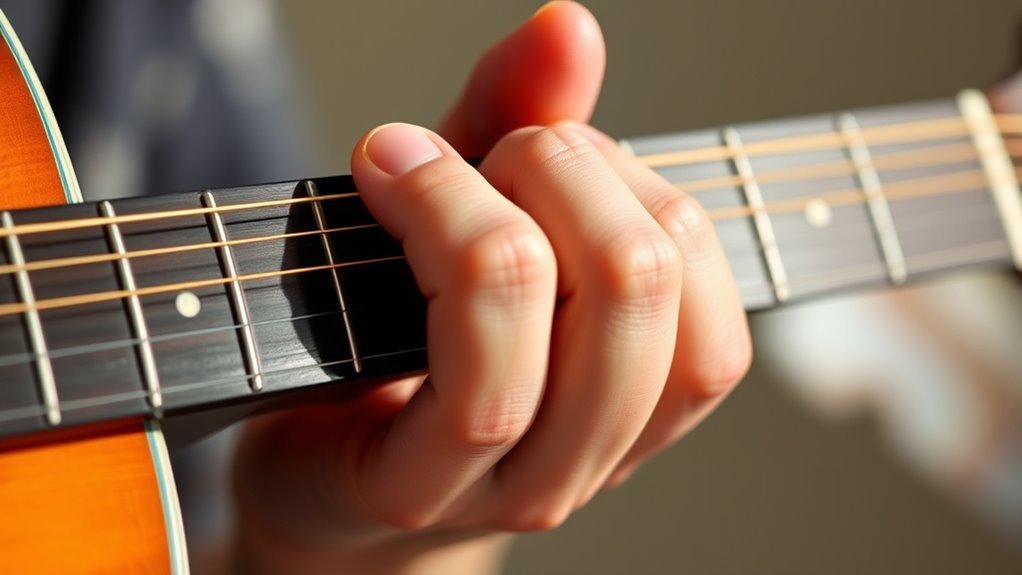
To play effective double-stops, you need to understand how to select two notes that complement each other harmonically. Focus on intervals that sound consonant and pleasing, like thirds, sixths, or fifths. These intervals create a rich, full sound without clashing.
Master the art of double-stops by choosing consonant intervals like thirds, sixths, or fifths for a rich, harmonious sound.
Here are the basic principles to keep in mind:
- Choose Harmonious Intervals: Stick to intervals that blend well, avoiding dissonant combinations unless intentionally used for tension.
- Maintain Proper Finger Placement: Keep your fingers firm and close to the fretboard for clarity and ease of transition.
- Consider the Context: Match your double-stops to the chord or melody you’re playing, ensuring they support the musical phrase.
Mastering these principles helps you craft compelling, harmonious double-stops effortlessly.
Common Double‑Stop Shapes and Patterns
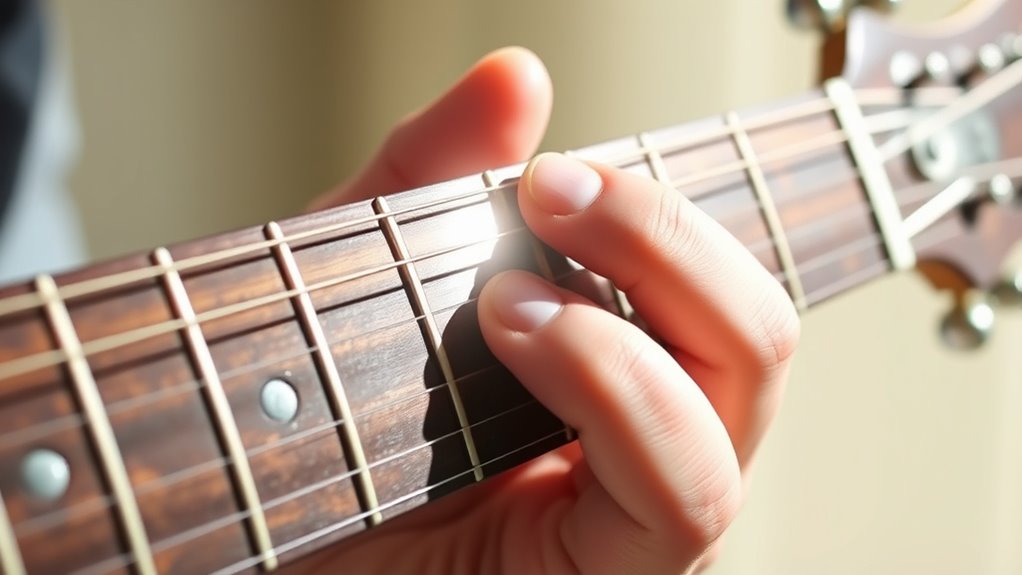
You’ll find that mastering basic double‑stop positions gives you a strong foundation for improvising and comping. Recognizing common interval patterns helps you create richer sounds quickly. Movable shape variations let you adapt these patterns to different keys and musical contexts effortlessly. Incorporating efficient composition techniques into your practice can also inspire innovative ways to approach chord shapes and textures.
Basic Double-Stop Positions
Have you ever wondered how guitarists quickly add richness to their playing? Basic double-stop positions are essential tools for this. They are simple, movable shapes that you can use across the fretboard to create fuller sound.
Here are the key positions to master:
- Root-Note Double-Stops – played on adjacent strings, focusing on the root note for harmony.
- Pentatonic Double-Stops – based on the pentatonic scale, offering a bluesy or melodic flavor.
- Barre Double-Stops – using one finger to bar multiple strings, creating thick, powerful sounds.
Practicing these positions helps you develop fluidity, expand your vocabulary, and add expressive depth to your playing. Mastering these shapes accesses endless creative possibilities. Incorporating these fundamental guitar techniques can significantly enhance your improvisation and songwriting skills. Additionally, understanding musical theory related to these shapes can further improve your improvisational abilities.
Common Interval Patterns
Understanding common interval patterns is essential because they form the foundation for recognizable double-stop shapes that you can quickly incorporate into your playing. These patterns often repeat across the fretboard, making it easier to memorize and apply them in different musical contexts. The most common intervals used in double-stops are thirds, sixths, and fourths, each creating distinct sounds and textures. For example, playing two strings a third apart yields a rich, harmonized sound, while sixths add brightness. Recognizing these patterns helps you develop fluid phrasing and improvisation skills. Practice these shapes across different positions and keys to internalize their sound and feel. Mastering common interval patterns allows you to build bigger chords effortlessly and improvise with greater confidence. Proper technique is also crucial to ensure clean, accurate double-stops and avoid muddiness or unintended noise.
Movable Shape Variations
Ever wondered how to move double-stop shapes seamlessly across the fretboard? You can do this by mastering common movable shape patterns. These shapes serve as building blocks for more complex chords and melodies. To get started:
- Root-5 Shapes: These are two-note shapes based on the root and fifth, movable up and down the neck, perfect for blues and rock.
- Root-3 Shapes: Incorporate the root and third intervals, creating major or minor sounds that fit various musical contexts.
- Sixth-String Shapes: Use shapes rooted on the sixth string for broad, open-sounding double-stops that span multiple frets.
Practicing these shapes across different keys helps you develop fluidity, making your playing more versatile and expressive.
How to Incorporate Double‑Stops Into Your Chord Progressions

Incorporating double-stops into your chord progressions can add richness and complexity to your playing, making simple progressions sound more dynamic. To do this, start by identifying key moments where a double-stop can enhance the harmony. For example, replace a single note or power chord with a double-stop that adds a complementary interval, like a third or sixth. You can also add double-stops between chords to create smoother shifts or to emphasize key moments. Experiment by playing two notes from different chords simultaneously, or slide into double-stops from nearby positions for a seamless sound. Keep your hand relaxed and focus on maintaining clear tone. Paying attention to vibrational energy can also help you connect more deeply with your musical expression. Developing an understanding of harmony principles will further enrich your improvisation and chord choices. With practice, double-stops will become a natural way to spice up your chord progressions and add harmonic interest.
Using Double‑Stops to Add Harmonic Interest to Solos

Using double-stops in your solos can instantly boost melodic texture and keep your lines interesting. They help create smooth harmonic movement, making your playing sound more dynamic. Plus, adding these intervals brings depth and color, giving your solos a richer, more expressive feel. Incorporating musical phrasing techniques can also serve as a reminder of the importance of guidance and support in your musical journey. Understanding the rhythm behind your playing can further enhance your ability to craft compelling solos that resonate with your audience.
Enhancing Melodic Texture
Double-stops are a powerful tool for enriching the melodic texture of your solos. They add depth and complexity, making your lines more engaging. To enhance your melodic interest:
- Combine intervals creatively — mix thirds, sixths, and other intervals to create colorful, expressive lines. Incorporating breed diversity in your harmonic choices can lead to richer sounds.
- Vary the rhythm — play double-stops with different note durations to introduce rhythmic variety and sustain interest.
- Use melodic movement — slide, bend, or hammer-on between double-stops to add smoothness and fluidity to your phrasing.
- Incorporate biodiversity concepts — understanding how ecosystems thrive through diverse interactions can inspire you to explore varied harmonic combinations and textures in your playing.
Creating Harmonic Movement
Adding harmonic movement to your solos can considerably enhance their emotional impact and musical interest. Using double-stops allows you to create this movement smoothly, without losing melodic flow. By shifting between different double-stops, you introduce new harmonic colors that keep the listener engaged. For example, moving from a simple double-stop to a nearby one adds tension and release. You can also target chord tones or scale notes to emphasize key moments, making your solos more dynamic. Experiment with sliding or bending between double-stops to add expressive nuances. Remember, subtle shifts can have a powerful effect, guiding the listener through a musical journey. Incorporating harmonic movement with double-stops makes your solos more compelling and gives them a richer, more layered sound.
Adding Depth and Color
Incorporating double-stops into your solos can substantially enrich their harmonic texture and emotional depth. They add a layer of complexity that captures the listener’s attention and makes your playing more expressive. To effectively add depth and color:
- Use double-stops to highlight key notes within a chord, creating a richer sound.
- Combine double-stops with melodic bends or vibrato for emotional impact.
- Experiment with different intervals, like thirds or sixths, to introduce unexpected tonal colors.
Tips for Smooth Transitions Between Single Notes and Double‑Stops

To achieve smooth shifts between single notes and double-stops, focus on relaxing your fingers and maintaining consistent hand positioning. Tension slows down your movement and makes transitions choppy, so stay loose and avoid unnecessary force. Before changing, anticipate the move by lifting or shifting your fingers smoothly, rather than jerking or rushing. Keep your hand anchored in a comfortable position, so your movements are controlled and fluid. Practice slow, deliberate transitions to develop muscle memory, ensuring your fingers move seamlessly between single notes and double-stops. Use visual cues, like focusing on the target fret or string, to guide your hand. Consistent practice with attention to relaxation and positioning will help you make cleaner, more connected transitions.
Exercises to Develop Your Double‑Stop Technique
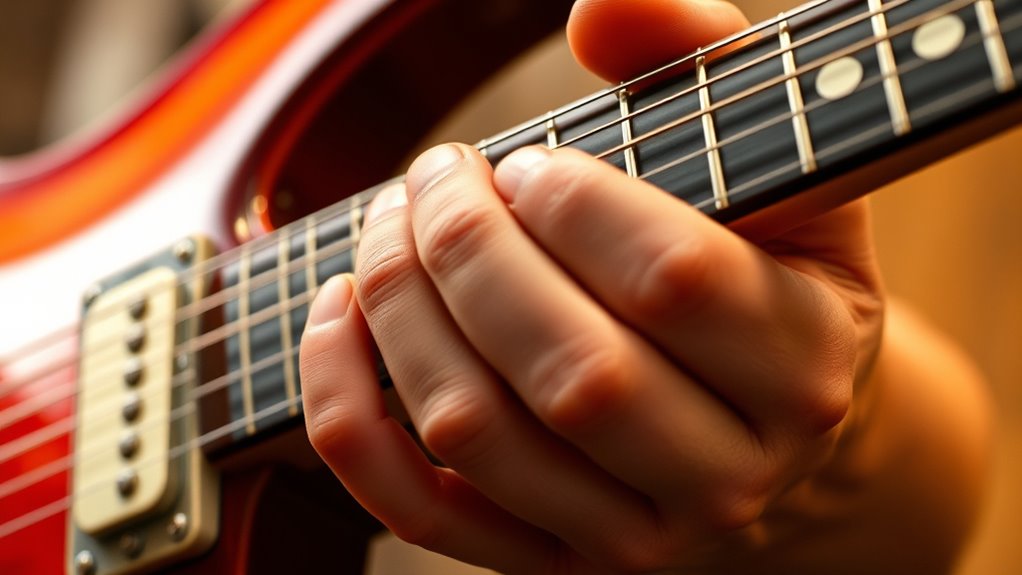
Practicing specific exercises is essential to building your double‑stop technique and gaining confidence in playing larger, more expressive chords. These exercises help develop finger independence, accuracy, and smooth progression.
- Start with simple double‑stops on adjacent strings, moving up and down the fretboard to build muscle memory.
- Practice sliding double‑stops between positions to improve control and fluidity.
- Incorporate rhythmic patterns, such as eighth or sixteenth notes, to develop timing and precision.
Repeat these exercises regularly, gradually increasing speed and complexity. Focus on clean, clear notes and consistent finger placement. Over time, you’ll develop the strength and coordination needed to incorporate double‑stops seamlessly into your playing, expanding your musical vocabulary.
Creative Ways to Use Double‑Stops for a Fuller Sound
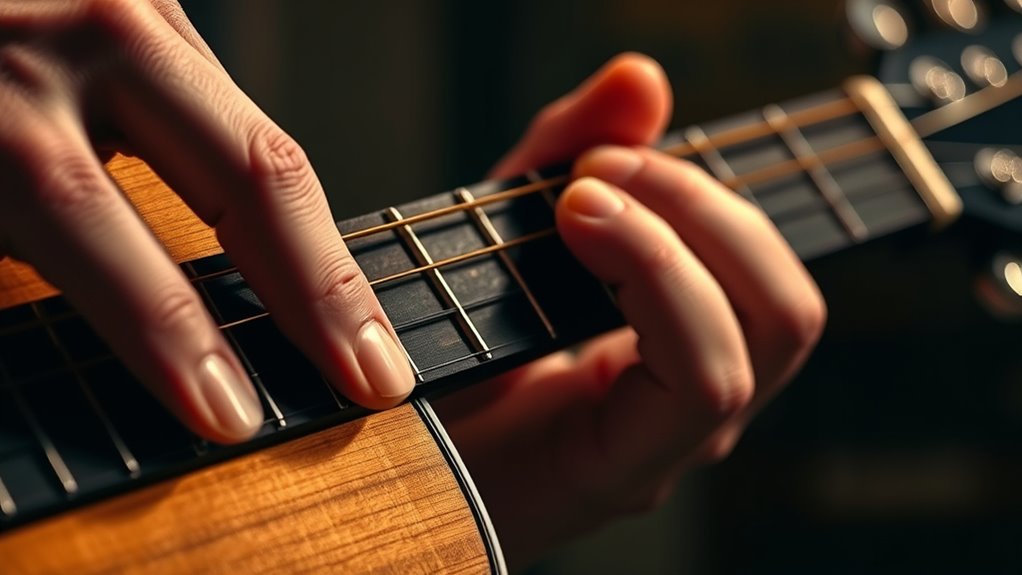
Double-stops can instantly add richness and complexity to your sound when used creatively. Try combining double-stops with slides or bends to create smooth, expressive progressions that sound bigger and more more dynamic. Incorporate double-stops into riffs or melodic lines to build tension and release, making your playing feel fuller. Experiment with voicing double-stops across different strings to evoke harmonies similar to chords, even when you’re soloing. You can also use double-stops as passing tones between single-note lines, giving your phrases more depth. Adding vibrato or subtle dynamics to your double-stops enhances their fullness and emotional impact. These techniques help you craft a layered, textured sound that resonates more powerfully, making your guitar sound larger without needing extra players or complex chords.
Frequently Asked Questions
How Do Double-Stops Differ Across Various Guitar Styles?
You might wonder how double-stops change with different guitar styles. In blues, you often use simple, expressive double-stops to add emotion. In jazz, they become more complex, incorporating bends and extensions for richness. Metal guitarists favor aggressive, fast double-stops in power chords, while country players use them for twangy, melodic fills. Each style adapts double-stops to serve its unique sound and feel, making them versatile across genres.
Are There Specific Genres Where Double-Stops Are More Prevalent?
You’ll find double-stops more prevalent in genres like blues, jazz, and country, where expressive playing and melodic embellishments are key. These genres often use double-stops to add richness, create harmonies, or evoke emotion. As you explore these styles, you’ll notice how players use double-stops to enhance their solos and chord voicings, making your playing more dynamic and soulful. Incorporating double-stops can truly elevate your musical expression.
Can Double-Stops Be Used Effectively in Fingerpicking?
You can definitely use double-stops effectively in fingerpicking. They add richness and harmonic complexity to your playing, making melodies more expressive. When fingerpicking, you can seamlessly incorporate double-stops by plucking two strings simultaneously or in quick succession. Practice shifting between single notes and double-stops smoothly. This technique enhances your musicality, especially in genres like folk, blues, and country, where double-stops create a fuller, more emotive sound.
What Are Common Mistakes Beginners Make With Double-Stops?
Imagine building a house without a solid foundation—that’s what beginners often do with double-stops. They tend to play too fast, miss muting strings, or neglect proper finger placement. These mistakes weaken your sound and clarity. Focus on clean, deliberate notes, and practice slowly. Don’t rush; instead, build your skills gradually. Mastering these basics will make your double-stops smoother, more expressive, and much more effective in your playing.
How Can I Incorporate Double-Stops Into Improvisation?
To incorporate double-stops into your improvisation, start by identifying key intervals and melodies within the key you’re playing. Experiment by adding double-stops on chord tones and emphasizing them during solos. Use slides, bends, or vibrato to make them expressive. Practice integrating double-stops gradually, listening for how they enhance your phrasing and harmony. This approach makes your improvisation richer and more dynamic, giving your solos more color and depth.
Conclusion
Now that you know how double-stops can instantly expand your chords and add richness, don’t just see them as shortcuts. Use them to challenge your creativity, blending simple melodies with complex harmonies. Like a secret weapon, they can transform your playing from basic to expressive. So, embrace the technique, experiment boldly, and let double-stops be your bridge from ordinary to extraordinary—because sometimes, the smallest change makes the biggest difference.









